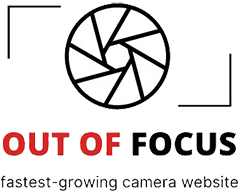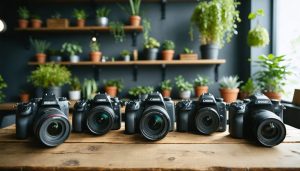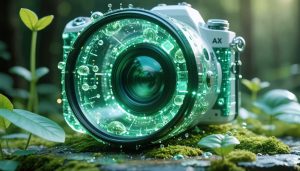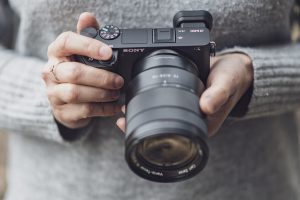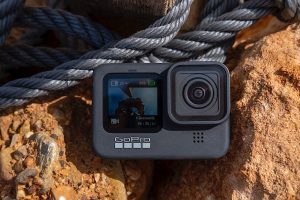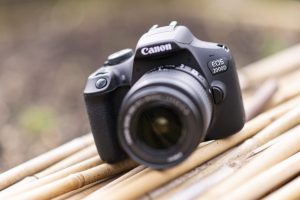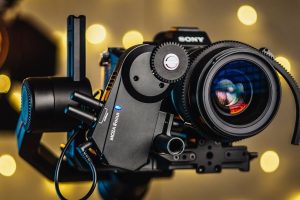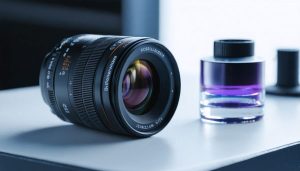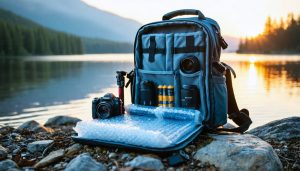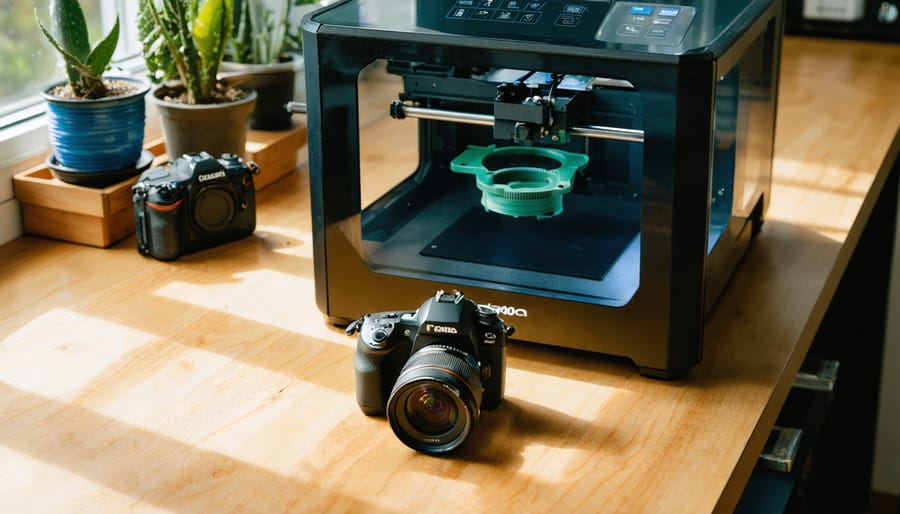
Picture your camera bag: lens caps that cracked after a single drop, battery grips with stripped threads, cold shoe adapters that never quite fit right. Now imagine printing exact replacements at home using materials made from cornstarch that’ll break down in your compost bin within months. This isn’t science fiction—it’s the reality of environmentally friendly 3D printing for photographers.
The photography industry generates significant plastic waste through disposable accessories, proprietary parts with planned obsolescence, and packaging that ends up in landfills. Meanwhile, 3D printing technology has evolved beyond petroleum-based plastics to offer biodegradable filaments, recycled materials, and even wood-composite options that can transform how you approach sustainable camera customizations.
The intersection of additive manufacturing and photography equipment creates unique opportunities. You can design a lens hood that fits your specific shooting style, print a custom flash diffuser for macro work, or fabricate organizational solutions for your gear bag—all while reducing your environmental footprint. But the process isn’t without complications. Failed prints waste material, not every biodegradable filament offers the durability camera gear demands, and the learning curve can frustrate even tech-savvy photographers.
This guide examines the practical reality of eco-friendly 3D printing for camera accessories. You’ll discover which materials genuinely reduce environmental impact, learn specific projects worth your time and filament, and understand when traditional manufacturing still makes more sense. Whether you’re tired of replacing the same broken part or simply want to align your gear choices with your values, the technology exists today to make both happen.
Why Camera Customization Needed a Green Revolution
The Hidden Environmental Cost of Your Camera Bag
Every time you unbox a new lens hood, camera grip, or mounting bracket, you’re participating in a surprisingly wasteful system. The camera accessory industry generates massive amounts of environmental waste that most photographers never consider. Let’s look at the real numbers.
Major manufacturers typically produce accessories in batches of thousands, leading to significant overstock. Industry reports suggest that approximately 30% of plastic camera accessories end up as unsold inventory, eventually destined for landfills. That lens hood sitting in a warehouse for three years? It’s already contributing to the problem before anyone uses it.
The materials themselves tell an even more troubling story. Most camera grips and battery holders are made from ABS plastic mixed with other materials, making them nearly impossible to recycle. When your camera grip cracks after a few years of use, there’s essentially nowhere for it to go except the trash. The same applies to lens hoods, flash diffusers, and countless mounting systems gathering dust in your closet.
Consider the packaging waste too. Each small accessory arrives in molded plastic clamshells, cardboard boxes, and protective foam that serves its purpose for mere seconds before disposal. A photographer upgrading their kit might generate several pounds of packaging waste in a single shopping trip.
While some eco-friendly camera gear brands are working to address these issues, the traditional supply chain remains problematic. This is precisely where 3D printing offers a compelling alternative, allowing photographers to create only what they need, when they need it.

What Makes 3D Printing Actually Eco-Friendly
Biodegradable Filaments That Actually Work for Camera Gear
When it comes to printing camera accessories that won’t spend centuries in a landfill, you’ll want to get familiar with a few standout materials. The good news? Several biodegradable filaments have evolved far beyond their early brittle, finicky predecessors.
PLA (Polylactic Acid) remains the most accessible eco-friendly option, derived from renewable resources like cornstarch or sugarcane. For camera gear, standard PLA works surprisingly well for items like lens cap holders, cable organizers, and cold shoe adapters that don’t face extreme stress. I’ve been using a PLA-printed flash diffuser for over two years, and it’s held up beautifully through countless shoots. The key limitation? Heat sensitivity. Leave a PLA item in a hot car or near studio lights, and you might find it warped beyond recognition.
For accessories requiring more durability, PLA+ offers enhanced strength and layer adhesion while maintaining biodegradability. It’s my go-to for tripod quick-release plates and filter wrenches that need to handle moderate torque without cracking.
PETG presents an interesting middle ground. While not as quickly biodegradable as PLA, it’s recyclable and offers excellent impact resistance and flexibility. This makes it ideal for protective camera body bumpers or lens hoods that might take the occasional knock. It prints nearly as easily as PLA but handles temperature extremes far better, making it practical for outdoor photography gear.
For truly demanding applications like gimbal counterweights or heavy-duty clamps, consider bio-based nylon filaments. These contain renewable content while delivering professional-grade strength. They require more printing experience and typically need an enclosure, but the results rival traditional petroleum-based plastics.
The reality? Match your material to your accessory’s demands, and these eco-friendly options perform remarkably well for real-world photography needs.

Recycled Materials: Printing Camera Parts from Plastic Bottles
Recycled filament offers photographers an excellent way to reduce environmental impact while creating custom camera gear. These materials are typically made from post-consumer plastic waste, including water bottles, food packaging, and industrial scraps that have been cleaned, shredded, and reformed into 3D printing filament.
The quality of recycled filaments has improved dramatically in recent years. Modern recycled PET (rPET) and recycled PETG perform nearly identically to their virgin counterparts, making them suitable for functional camera accessories like lens cap holders, camera stands, and cable organizers. However, recycled filaments may show slight color variations between batches since they’re sourced from mixed plastics, which adds a unique character to your prints rather than being a drawback.
Several manufacturers now specialize in recycled filaments specifically for 3D printing. Look for brands that provide transparency about their sourcing and processing methods, ensuring consistent diameter and minimal contaminants. Prices are often comparable to standard filaments, typically ranging from $20-30 per kilogram.
For the truly dedicated, creating your own recycled filament is possible but requires investment in specialized equipment. Desktop filament extruders cost between $500-2000 and can transform shredded plastic bottles into usable filament. This approach works best for photographers who print frequently or want complete control over their materials.
A practical starting point is simply purchasing certified recycled filament from reputable suppliers. Start with non-critical prints like battery organizers or memory card cases to familiarize yourself with how recycled materials behave during printing before moving to more complex camera accessories.
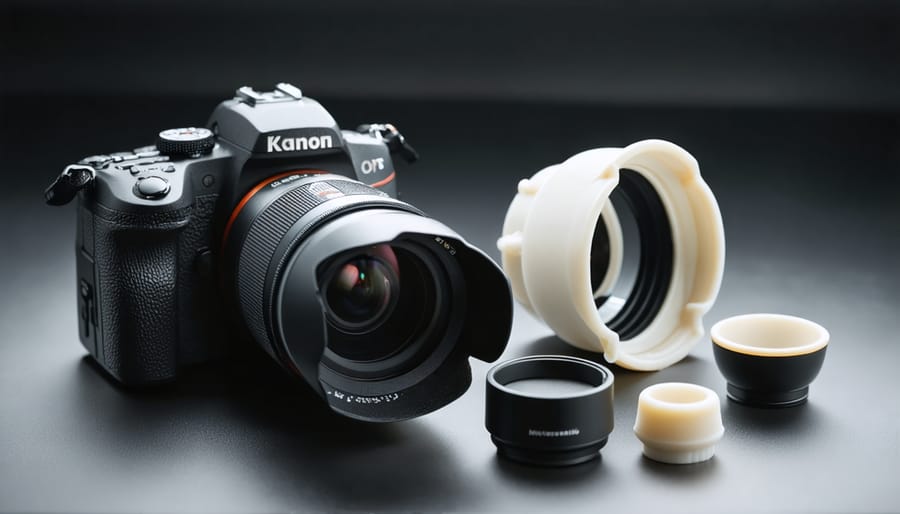
Camera Accessories You Can Print Right Now
Custom Lens Hoods and Filter Holders
Generic plastic lens hoods often come in one-size-fits-most designs that aren’t optimized for your specific lens and shooting style. With 3D printing, you can create custom lens hoods tailored to your exact focal length and filter setup, eliminating the need to purchase multiple versions that end up in landfills.
Start by exploring repositories like Thingiverse or Printables, where photographers share lens hood designs for specific camera models. Many designs include parametric files you can adjust for your exact lens diameter and depth requirements. If you can’t find your model, basic CAD software like Tinkercad or Fusion 360 makes it surprisingly straightforward to design a custom hood. Measure your lens diameter, determine your desired hood depth based on your focal length, and create a tapered cylinder that blocks side light effectively.
The real environmental win comes when you print filter holders that accommodate multiple filters simultaneously. Instead of buying separate systems for polarizers, ND filters, and step-up rings, you can design integrated solutions using biodegradable PLA. This approach works particularly well with camera sun hoods for outdoor photography, where customization prevents flare in challenging lighting conditions. When a hood breaks or you upgrade lenses, simply recycle the PLA and print a new one.
Ergonomic Camera Grips and Handles
Long shooting days can leave your hands cramped and uncomfortable, especially when your camera’s standard grip doesn’t quite match your hand size or shooting style. Instead of purchasing expensive aftermarket grips that still might not fit perfectly, you can design and 3D print custom ergonomic handles tailored to your exact grip preferences.
The beauty of this approach lies in personalization. You can measure your hand, analyze how you naturally hold your camera, and create a grip that fills gaps or extends surfaces exactly where you need support. For instance, if you have larger hands and find your mirrorless camera too small for comfortable handling, you can design an extended grip that wraps around the camera body, providing additional surface area without adding excessive bulk.
Using biodegradable PLA filament makes this customization environmentally responsible. If your first design doesn’t feel quite right, simply compost the print and iterate on the design. This trial-and-error process, which would be wasteful with traditional manufacturing, becomes sustainable when using plant-based materials.
Consider starting with simple modifications like adding texture or finger grooves to an existing grip design from online repositories. As you gain confidence, you can create entirely custom solutions that address your specific needs, whether that’s accommodating arthritis, improving stability for video work, or simply making your camera feel more natural in your hands.
Mounting Solutions and Tripod Adapters
Custom mounting solutions represent one of the most practical applications of eco-friendly 3D printing for photographers. Instead of purchasing multiple proprietary adapters that often come in excessive plastic packaging, you can design and print exactly what you need using sustainable materials like PLA or recycled filaments.
Quick-release plates are perfect starter projects. Print custom plates that fit your specific camera bodies, eliminating the wobble that sometimes occurs with generic options. For macro photography enthusiasts, you can create dedicated focusing rail adapters that precisely fit your lens setup. I’ve seen photographers print vertical L-brackets that rival expensive aluminum versions, providing the same functionality at a fraction of the environmental cost.
Overhead shooting rigs benefit enormously from 3D printing. You can design lattice-structured boom arms that are strong yet use minimal material, or create custom clamps that attach to existing light stands. One photographer I know printed an entire tabletop product photography setup, including adjustable camera mounts and backdrop holders, using a single spool of recycled PETG.
The real advantage is iteration without waste. If your first tripod adapter doesn’t quite work, simply redesign and reprint. Many failed prints can be recycled back into filament, creating a closed-loop system that traditional metal machining can’t match. Start with simple flat adapters before progressing to more complex articulating arms and multi-axis mounts.
Storage and Organization Systems
If you’re like most photographers, you’ve probably accumulated a chaotic collection of batteries, SD cards, lens caps, and cable adapters that seem to multiply in your camera bag. Instead of buying new plastic organizers that eventually crack or break, you can 3D print customized storage solutions using environmentally friendly materials like PLA or recycled PETG.
The beauty of designing your own storage systems is that you can create exactly what you need. Print a battery holder that fits perfectly in your bag’s pocket, or design a modular SD card case that stacks vertically to save space. One photographer I know printed a cable management system with individual compartments for each USB-C, micro-USB, and Lightning cable, eliminating the tangled mess that used to waste precious shooting time.
Think modular when designing these systems. Create interlocking components that can expand as your gear collection grows, rather than printing one massive organizer that becomes obsolete when you upgrade equipment. This approach reduces material waste and extends the useful life of your printed items. Consider adding labels or color-coding different sections using plant-based filaments in various natural tones, making it easy to grab what you need without fumbling through compartments during a shoot.
Choosing the Right Eco-Friendly 3D Printing Approach
When to Use a Printing Service vs. DIY
Deciding between printing at home and using a service involves more than just cost. From an environmental perspective, professional printing services often have a smaller carbon footprint per part, especially if you’re just starting out or only need occasional custom pieces.
Here’s the reality: your first dozen lens cap holders might end up in the recycling bin as you refine your design and learn proper printing techniques. That wasted filament, combined with hours of electricity running your printer, adds up quickly. Professional services typically run optimized machines with minimal waste and bulk material purchasing that reduces packaging and transportation emissions.
Consider using a printing service when you need a single complex item, like a custom flash diffuser with intricate geometry, or when you’re prototyping a design you haven’t perfected yet. Many services also offer industrial composting for PLA prints, something most home users can’t access. The electricity savings alone can be significant. A typical home 3D printer running for 8 hours uses roughly the same power as leaving your computer on all day, multiplied across dozens of failed attempts during your learning curve.
DIY makes sense once you’ve mastered the basics and print regularly. If you’re producing multiple camera accessories monthly or creating standardized items you’ve already perfected, the environmental cost per part drops dramatically. You’ll also have complete control over material selection, ensuring you’re using the most sustainable filaments available. The sweet spot? Start with services, transition to DIY as your skills and needs grow.
Reducing Waste in Your 3D Printing Workflow
The Reality of Failed Prints and How to Minimize Them
Let’s be honest: print failures happen to everyone, even experienced makers. Whether it’s a lens cap holder that warps halfway through or a flash bracket that detaches from the build plate, failed prints are part of the 3D printing learning curve. The good news? With proper setup and attention to detail, you can significantly reduce waste while embracing sustainable photography practices.
Start by investing time in calibration. Level your print bed carefully, dial in the correct temperature for your chosen filament, and run test prints before committing to large camera accessories. A small calibration cube uses minimal material but can save you from wasting an entire spool on a failed telephoto lens hood. Keep detailed notes about successful settings for each material type.
When failures do occur, don’t simply toss them in the trash. PLA prints can often be composted in industrial composting facilities, though check with your local facility first as home composting rarely reaches the necessary temperatures. Some companies now accept PLA returns for proper processing. PETG prints can sometimes be recycled through specialized plastic recycling programs, though again, verification with local facilities is essential.
Consider keeping failed prints as test pieces for paint techniques or modifications. That botched camera grip prototype might become your experimentation piece for different finishing methods. Some makers even grind failed prints into pellets for reuse, though this requires additional equipment and careful material separation.
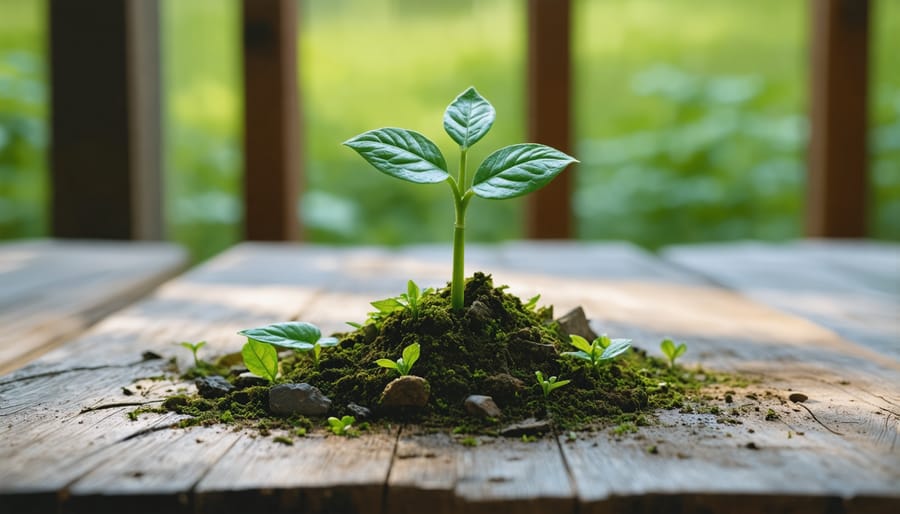
Real Photographers Making the Switch
When Seattle-based wedding photographer Maria Chen started experimenting with eco-friendly 3D printing in 2022, she wasn’t sure if biodegradable materials could handle professional use. After two years of creating custom lens hoods, battery grips, and cable organizers using PLA filament, she’s completely converted. “I’ve printed over fifty custom accessories, and only three have failed due to material limitations,” Maria shares. “The real turning point was discovering that PLA actually performs better than ABS in most situations where I don’t need heat resistance.”
Maria’s workflow now includes designing custom tripod adapters for unique shooting angles at outdoor weddings. She’s reduced her equipment costs by roughly 40 percent while eliminating the packaging waste from retail purchases. Her biggest lesson? Start with simple, non-critical accessories before moving to items that need to withstand heavy use.
Commercial photographer James Rodriguez took a different approach in Austin, focusing specifically on recycled PETG for studio accessories. He’s created an entire system of modular lighting modifiers and backdrop clips that he can repair or modify on demand. “When a client needs a specific solution, I can design and print it overnight using recycled materials,” he explains. His studio has eliminated nearly all single-use plastic from equipment purchases.
The learning curve proved steeper than expected. James estimates he wasted about three kilograms of filament on failed prints during his first six months, though he now composts his PLA failures in his backyard system. His advice for photographers starting out? Join online communities where experienced users share print settings optimized for camera accessories. The collective knowledge saved him months of trial and error and prevented significant material waste.
Embracing eco-friendly 3D printing for your camera customization projects offers a meaningful way to reduce your environmental footprint while enhancing your photography toolkit. The combination of biodegradable materials like PLA, the ability to print only what you need, and the potential for recycling failed prints creates a compelling case for this approach. Beyond the environmental benefits, you gain the creative freedom to design accessories that match your exact shooting style, whether that’s a custom lens hood for your favorite vintage lens or a specialized bracket for your unique lighting setup.
The beauty of this approach is that you don’t need to overhaul your entire workflow overnight. Start with one simple project, perhaps a lens cap holder or a camera strap mount. This allows you to familiarize yourself with the printing process, understand material behavior, and build confidence without significant investment. As you gain experience, you can tackle more complex accessories and refine your designs based on real-world use.
Remember that sustainable photography extends beyond just your printing choices. Integrating eco-friendly 3D printing with other eco-friendly photography practices creates a more comprehensive approach to reducing your impact. Every small change contributes to a larger movement toward environmental responsibility in our craft. The camera accessories you print today represent not just practical solutions, but a commitment to thoughtful, sustainable creativity in photography.
